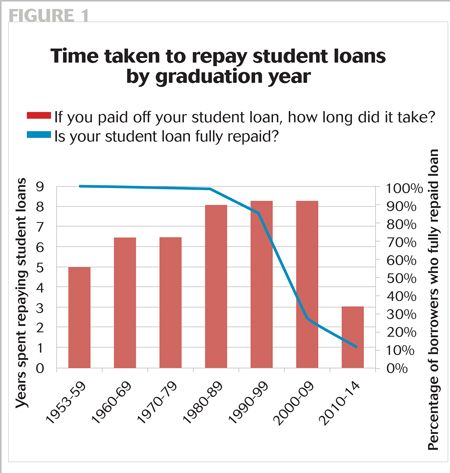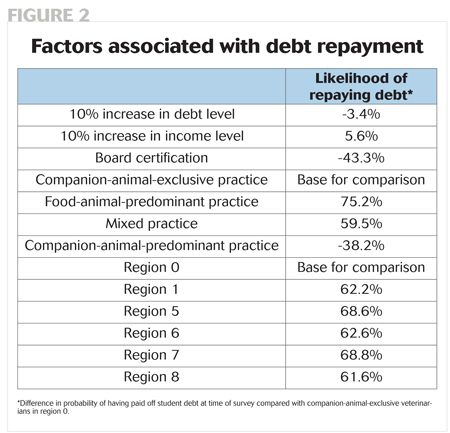Repayment realities: Why do some DVMs take longer to pay off student debt?
Demographic factors correlate with shorterand longerveterinary loan payback periods.
Over the past decade student loan debt in the United States has doubled, with the average student loan amount for a four-year degree clocking in at $30,100, according to a 2015 report from the Institute for College Access and Success, a nonprofit dedicated to college affordability.1 But we all know it's worse for those in postgraduate work. The American Veterinary Medical Association (AVMA) estimates that in 2016, mean debt incurred by veterinary graduates while they were veterinary college students was $143,758-that's double the debt from 2005.
Meanwhile, the mean 2016 starting salary for new veterinarians-excluding those participating in internships, residencies or advanced education-was $73,812, making the debt-to-income ratio for new veterinary graduates just shy of 2-to-1. That ratio makes paying that loan a financial burden.
The ‘survival analysis'
Veterinarians incur different levels of student debt, and they service that debt at different paces of repayment. An analysis of the 2016 AVMA Census of Veterinarians data found that:
> More than 75 percent of respondents incurred debt in funding their veterinary education.
> Twenty percent of those who graduated between 1996 and 2014 are debt-free.
> Forty percent of those with more than 20 years' professional experience are debt-free.
To dive deeper into these findings, we looked at survey respondents' employment type, amount of debt held, gender, annual income and other demographic variables to see if they correlated to the pace of debt repayment. We analyzed this information in a “survival analysis” to calculate the “survival time” of debt-the duration between a veterinarian's graduation year and the year when all of his or her student debt is repaid.
Within our sample of 1,277 observations were 435 respondents who said they'd completely paid off their student loans at the time of the survey. Figure 1 summarizes, by decade of graduation, the average time taken to repay loans and the percentage of respondents who have finished repaying their loans.

The condensed results of our survival analysis are presented in Figure 2. The most important factors affecting debt repayment appear to be the initial debt level itself and income at the time of the survey. An increase of 10 percent in debt decreased by 3.4 percent the probability of having fully repaid the student debt. Conversely, every 10 percent increase in income increased by 5.6 percent the probability of repaying the debt. An important point-it appears that income has a higher effect on the ability to repay than the level of debt itself. Interestingly, we expected gender to be an important factor in our payback period analysis, but the results did not bear that out.

Figure 2 also reveals that food-animal-predominant veterinarians are 75 percent more likely to have cleared their student debt compared with companion-animal-exclusive veterinarians. Companion-animal-predominant veterinarians are 38 percent less likely to have fully serviced their student debt compared with companion-animal-exclusive. We included other practice types in our analysis but the results were not statistically significant so we omitted them from the table.
Other important factors affecting debt repayment include board certification and region of the United States. Veterinarians with board certification were 43 percent less likely to have serviced their entire debt compared with their colleagues with no certification, presumably because of the time spent in additional training and associated loan deferment or reduced payments over that period. In addition, veterinarians who work in regions 1, 5, 6, 7 and 8 (referring to the first digit of the ZIP code) all are significantly more likely to have repaid their debt than those in region 0. Regions 2, 3, 4 and 9 were not statistically significant and are omitted from the table.
Income vs. debt: What affects a debt-saddled veterinarian the most?
This analysis considers factors that might affect the pace at which veterinarians pay off their loans. However, because the debt-to-income ratio has risen sharply in the past decade, the analysis might not reflect which factors have greater impact on more recent graduates.
We were interested to find a significant difference in repayment period by practice type, though we offer no hypothesis as to why this occurs. The factors that may contribute to these differences warrant a closer examination.
Our analysis of net present value has shown that income is more important than debt to the overall lifetime value of a DVM degree,2 and this analysis further supports that conclusion, showing that income is 1.5 times as important in repaying debt than the veterinarian's initial debt level. We believe the links between veterinarians' income, debt and personal wellness levels are unexplored, so it will be interesting to see if the relative importance of income over debt also holds regarding wellness, and whether improving income or debt will yield a greater return on investment for the profession.
References
1. The Institute for College Access and Success. Student debt and the class of 2015. 11th Annual Report, October 2016, ticas.org/sites/default/files/pub_files/classof2015.pdf.
2. Dicks MR, Bain B, Knippenberg R, and Ouedraogo F. 2016 AVMA report on the market for veterinarians. American Veterinary Medical Association October 2016.
Director Mike Dicks, PhD, assistant director of economics Ross Knippenberg, PhD, and economic analyst Frederic Ouedraogo, PhD, all work at the AVMA's Veterinary Economics Division.